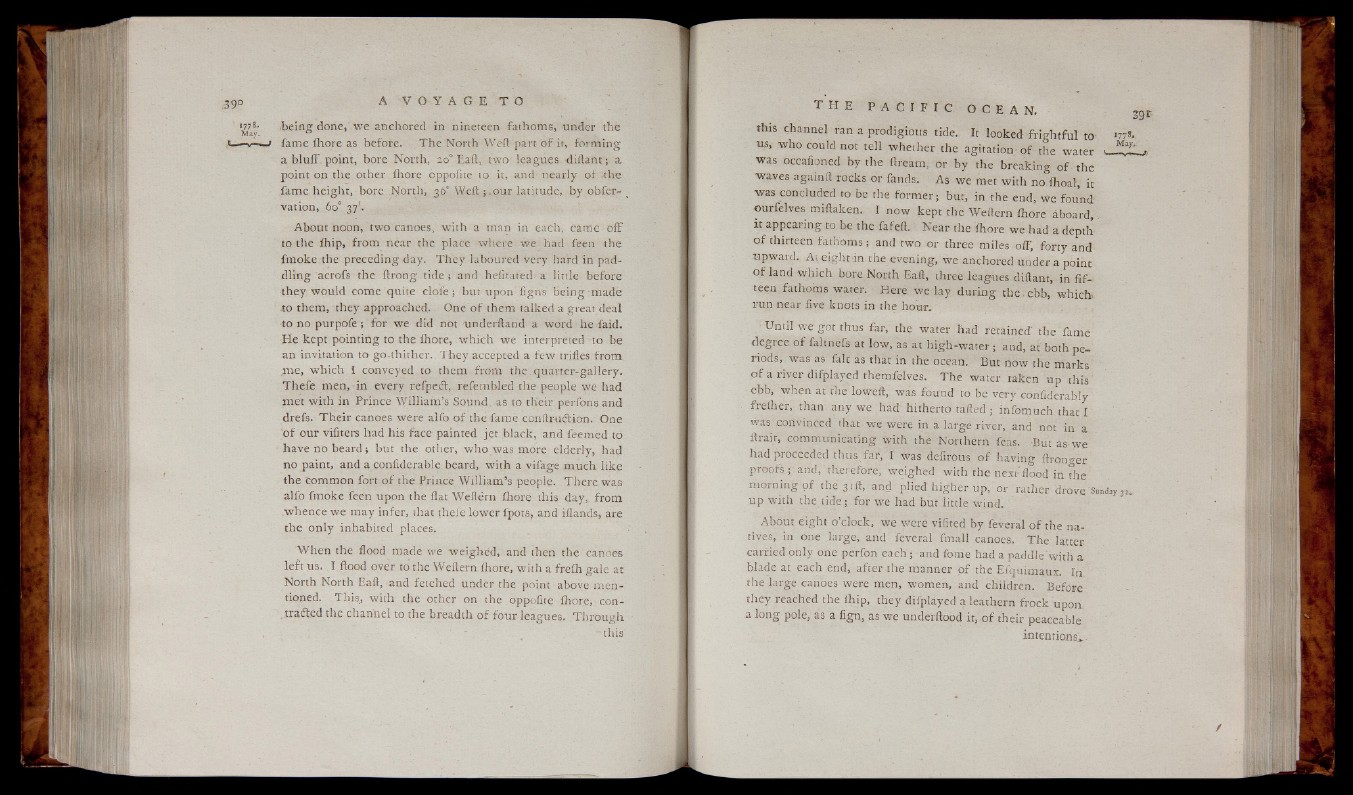
•being done, we anchored in nineteen fathoms, under the
fame ihore as before. T he North Weft part o f it, forming
a bluff, point, bore North, so"-Eaft, two leagues diftant; a
point on the other ihore oppofite to it, and nearly o f the
fame height, bore North, 36° Weft ;.o u r latitude, by obfer-
vation, 60° 37'.
About noon, two canoes, with a man in each, came o ff
to the ihip, from near the place where we had feen the
fmoke the preceding day. T h e y laboured very hard in paddling
acrofs the ftrong tide ; and hefitated a little before
the y would come quite c lo fe ; but upon figns be in g made
to them, they approached. One o f them talked a great deal
•to no purpofe ; for we did not underftand a word he faid.
He kept pointing to the ihore, which we interpreted to be
an invitation to go thither. They accepted a few trifles from
m e , w hich I conveyed to them from the.quarter-gallery.
The fe men, in every refpedt, refembled the people we had
met with in Prince William’s Sound as to their perfons and
drefs. T h e ir canoes were alfo o f the fame conftrudtion. One
'o f our vifiters had his face painted jet black, and ieemed to
have no beard ; but the other, who was more elderly, had
no paint, and a confiderable beard, with a vifage much like
the Common fort o f the Prince William’s people. There was
alfo fmoke feen upon the flat Weftern ihore this day, from
.whence we may infer, that thefe lower fpots, and iilands, are
the on ly inhabited places.
When the flood made we weigh ed, and then the canoes
left us. I flood over to the Weftern ihore, with a freih gale at
North North Eaft, -and fetched under th e 1 point above mentioned.
This, with the other on the oppofite ihore, con-
..tradled the channel to the breadth o f four leagues. Throu gh
- th is
this channel ran a prodigious tide. It looked fr igh tfu l to >77».
us, who could not tell whether the a gitation-of the water ■ May~ ,.r
Was occafioned by the ftream, or by the breaking o f the
waves againft rocks or fands. As we met with no ihoal, it
was concluded to be the forme r; bur, in the end, we found-
ourfelves miftaken. I now kept the Weftern ihore aboard,
it appearing to be the fafeft. Near the ihore we had a depth
o f thirteen fa th om s ; and two or three miles off, forty and
upward. At eight in the evening, we anchored under a point
o f land w h ich bore North Eaft, three leagues diftant, in fifteen
fathoms water. Here we la y d u r in g the, ebb, w h ich
run near five knots in the hour.
Until we got thus far, the water had retained the fame
degree o f faltnefs at low, as at high-water ; and, at both periods,
was as fait as that in the ocean. But now the marks
o f a river difplayed themfelves. T he Water taken up this
ebb, when at the loweft, was found to be very confiderahly
freiher, than any we had hitherto tailed | infomuch that I
was convinced that we were in a large river, and not in a
ill air, communicating with the Northern feas. But as-we
had proceeded thus far; I was defirous o f having ftrono-er
proofs ; and, therefore, weighed with the next flood in the
morning o f the 31ft, and plied higher up, or rather drove §§*by 3,_
up with the tide ; for we had but little wind.
About eight o’clock, we were vifited by feveral o f the natives,
in one large, and feveral fmall canoes. The latter
carried only one perfon each ; and fome had a paddle'with a
blade at each end, after the manner o f the Efquimaux. In
the large canoes were men, women, and children. Before
they reached the Ihip, they difplayed a leathern frock upon,
a long pole, as a fign, as we underftood it, o f their peaceable
intentions*